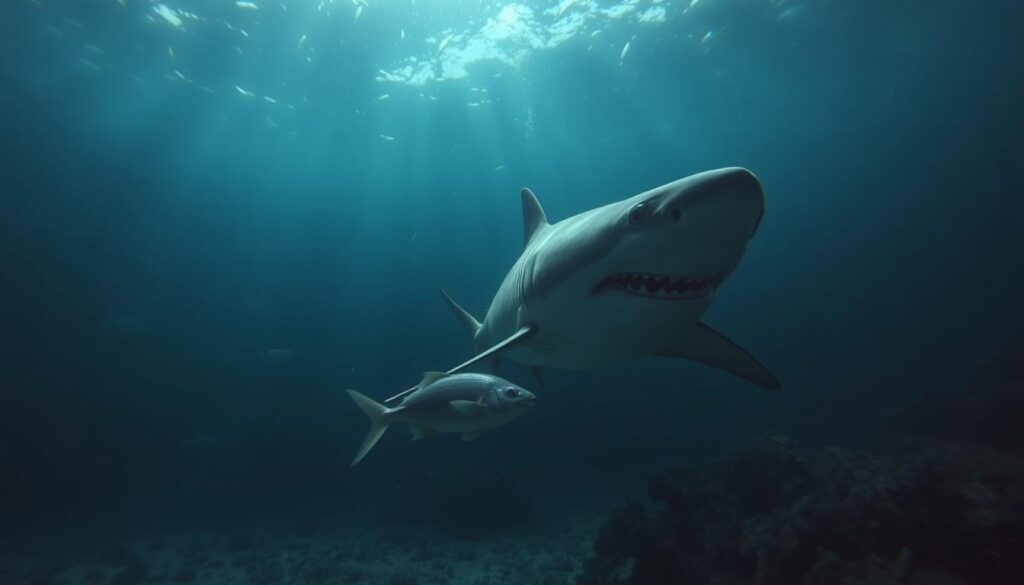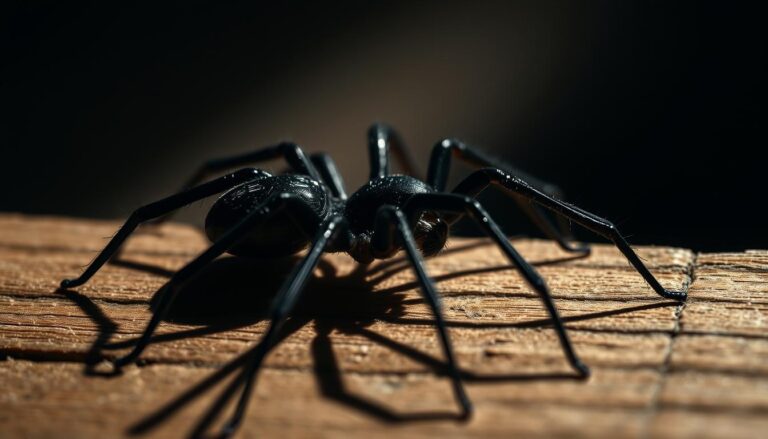
How do sharks use electroreception to hunt in darkness?: Did you know sharks can sense electrical signals in the water? This lets them hunt in the dark very well. Their electroreception skill helps them find prey far away, even in dark, murky waters. Over 500 shark species live in our oceans. Each one has special skills that help them live and hunt in different places. One important skill is electroreception. It helps these ancient hunters move through the ocean accurately.
The ampullae de Lorenzini are special parts that help with electroreception. They are on the sharks’ heads and snouts. These parts pick up tiny electrical fields from other animals moving. This makes hunting easier for them. Knowing how sharks use this skill helps us understand more about the sea. It shows us how predator and prey interact under the sea.
How do sharks use electroreception to hunt in darkness?: Key Takeaways
- Sharks have a unique ability to sense electrical signals in their environment.
- Electroreception allows sharks to hunt effectively in darkness and murky waters.
- Ampullae de Lorenzini are specialized structures that enable this sensory function.
- Over 500 species of sharks exhibit various adaptations for hunting and survival.
- Understanding these adaptations provides insight into the complex dynamics of marine ecosystems.
The Fascinating World of Sharks
Sharks are vital in keeping our oceans healthy. They have been around for about 400 million years. Their presence ensures the balance of marine ecosystems.
There is a wide variety of shark species, each suited to different marine settings. The great white shark is a prime example of these adaptations. However, their numbers are falling in the U.S. Pacific coast.
Each year, 80 to 100 million sharks are killed because of human actions. This includes hunting for their fins and getting caught in nets by accident. Their slow growth and low birth rates make this especially harmful.
But there’s hope for saving these important sea animals. The Bahamas plans to stop all shark fishing. Chile wants shark fins to stay on when brought to land. Some places in the U.S. are fighting against eating shark fins too.
We need to know how different sharks are and what they do for the ocean. As we learn about their special skills and senses, we see why it’s so important to protect them. Sharks are central to global conservation works.
Understanding Electroreception
Electroreception lets some water animals, like sharks, sense electric fields around them. This special skill helps sharks find their way and hunt when it’s hard to see. Their bodies have unique parts called ampullae de Lorenzini for this. These parts are filled with a jelly that picks up tiny electric signals from prey and other sea life.
What is Electroreception?
Some sea animals can feel bioelectric fields. This group includes sharks, rays, skates, and sawfish. Sharks are really good at this. They can sense very weak electric signs. Even signs as small as 0.1 microvolts per centimeter. Every time a fish breathes, it creates a tiny electric current. Sharks can use this to find prey. The ampullae de Lorenzini in sharks help them catch these weak signals. They make sharks better at noticing changes in water around them.
Discovery of Electroreception in Sharks
In 1966, a scientist named Adrianus Kalmijn discovered sharks could sense electric fields. This was a major moment for studying these amazing animals. Kalmijn found that sharks and their relatives could find prey because of this unique ability. Since then, scientists have learned a lot more. They’ve studied how these sensing parts work. They’ve also looked at how they’re different for hunting or talking to other sharks.
Sharks’ Sensory Adaptations
Sharks have evolved amazing senses for better hunting. Their sense of smell is incredible for finding food. They can smell tiny amounts of blood from far away. They also have great hearing. This helps them hear vibrations in the water. These skills make sharks powerful hunters in all types of water.
Other Senses of Sharks
Sharks use many senses together to hunt. Their main senses include:
- Smell: Sharks can smell prey cues and blood from miles away.
- Sight: They can see well, even in dim light.
- Hearing: Sharks can hear sounds up to 1,000 meters away, helping them find schools of fish.
How Electroreception Enhances Hunting Skills
Electroreception is key for sharks’ hunting. They have special organs called Ampullae of Lorenzini. These help them feel electric signals from moving prey. This is very useful in dark or murky waters. Fish breathe and move, making electric currents. Sharks can detect these, making them even better hunters.
How do sharks use electroreception to hunt in dark waters?
Sharks have special adaptations for hunting in dark places. They can use electroreception to find their prey. This ability lets them feel the electric fields that their prey gives off.
The Role of Ampullae de Lorenzini
Sharks have many ampullae de Lorenzini around their noses. These help them sense weak electric signals from prey. A big part of their brain works on smelling and sensing electricity.
Electroreception and Prey Detection
When sharks get close to their target, electroreception becomes key. They can find and move towards prey because of this. They might even roll their eyes back and just use electroreception to see.
Successful Hunting Strategies
Sharks’ hunting skills get better with electroreception. The salt in the water makes electric signals stronger. So, sharks can sense these signals well and change how they attack.
The Lateral Line System
The lateral line system is super important for sharks. It helps them hunt by working with another system called electroreception. Sharks have tiny holes on their sides that can feel changes in water pressure. This lets them sense movements and vibrations, helping them know where they are and find their prey.
How the Lateral Line Works
Thanks to the lateral line system, sharks can feel movements in the water. This is especially helpful when they can’t see well. They can sense objects moving or animals that are hurt. I’ve seen sharks use this to make perfect moves towards their target even when they can’t see it well. They rely on the changes in water they feel to adjust their approach.
Integration with Electroreception
Sharks use their lateral line system and electroreception together to be awesome hunters. They have special sensors for picking up electrical signals from prey. This helps them know exactly where their next meal is. By using both systems, sharks get a clear picture of their surroundings. This makes them super good at navigating and catching food.
The Importance of Smell in Shark Hunting

Sharks are amazing hunters, thanks to their sharp sense of smell. They can smell a tiny drop of blood in a huge amount of water. This unbeatable nose power helps them find food from far away.
Studies show sharks can smell their dinner from hundreds of yards away. Their noses are special, catching scents between their nasal openings. This makes them super good at hunting. They follow the smell to find and catch their prey.
Sharks also use other senses to find food. They can sense the tiny electric signals from other animals. Together with smell, this helps them find and get close to what they will eat next. For example, a blacktip shark can smell fish in very, very diluted water.
This mix of super senses makes sharks great at getting food. It also makes them very interesting as predators. Their smell and other senses work together, showing how smart they are in the water.
The Impact of Environmental Factors on Electroreception
Learning how sharks’ electroreception changes with the environment is key. Conditions like salinity levels greatly impact this skill. Sharks can sense electric signals, which helps them hunt. Next, we’ll see how different salt levels affect them.
How Water Salinity Affects Sensory Abilities
Water’s saltiness changes how sharks sense electricity. In freshwater, it’s tougher for them because it conducts less well. This makes sensing prey hard.
In saltier water, sharks sense weak electric fields better. When the water is less salty, their electroreceptors might not work as well. This can make hunting harder.
- In highly salty environments, the conductivity increases, enhancing a shark’s ability to detect weak electrical signals.
- As salinity decreases, the electroreceptors may not function as effectively, affecting hunting success.
Electrical Signals in Different Waters
Water type also affects electrical signals for sharks. They can sense very weak signals, helping them find prey far away. This ability is used for hunting and maybe even navigating in dark waters.
| Water Type | Electrical Signal Sensitivity | Salinity Level |
|---|---|---|
| Saltwater | High sensitivity to faint electrical fields | High salinity (35 ppt) |
| Freshwater | Reduced sensitivity to electrical signals | Low salinity (0-1 ppt) |
Sharks adjust to different waters to keep their electroreception sharp. Knowing these environmental effects shows how sharks interact with their habitat. This shapes their role as top predators in the ocean.
The Role of Electroreception in Shark Migration
Sharks travel far across oceans, showing amazing migratory behaviors. They don’t just use their eyes to find their way. Electroreception is key, helping them use Earth’s magnetic fields to navigate. This skill boosts their chances of survival and hunting success on long journeys.
Using Earth’s Magnetic Fields
Sharks have about 200 ampullae of Lorenzini. These are special electroreceptors. They can sense very small electric signals around them. These receptors help sharks sense prey from far away and navigate using Earth’s magnetic fields.
About 70% of shark species rely on electroreception to migrate. For example, the great white shark follows geomagnetic cues. This is crucial in dark or murky waters, where it’s hard to see.
Electroreception is also vital for hunting, not just migrating. It’s thought to help sharks catch prey in tough conditions up to 50% of the time. This shows how electroreception is an evolutionary advantage for migration and hunting.
Research and Discoveries in Electroreception

Research on electroreception has grown a lot over the years. It shows us how sharks and their relatives hunt. These findings help us learn more about how sea creatures sense things. Work from many years ago started this research. Today, it keeps on growing.
Historical Studies and Breakthroughs
Many studies have looked at the senses of different species. Early work focused on the little skate’s sensory organ. It gave us valuable info. Scientists found out about two important currents that help skates sense their world. This work shows how amazing sharks’ senses are.
Recent Findings and Implications
A study in Nature showed new things about shark and skate senses. Shark cells are very good at picking up electric signals. This helps them find their food. On the other hand, skate cells can adjust their response. This helps them talk to each other. Experiments showed that without certain ion channels, skates can’t sense hidden electric signals. This proves how important specific channels are for sensing electricity.
Sharks and skates can sense the tiny electric signals from heartbeats. This helps them find their prey. Their senses have special connections that send strong signals to their brains. These studies on electroreception tell us how sea life is related. They also show us how adaptable their senses are. Maybe one day, this will help us understand our own senses better.
The Future of Shark Conservation and Management
Sharks play a key role in keeping oceans healthy. When thinking about their future, we need new ideas for protection. The way sharks sense electric fields can help us. This can make fishing safer for sharks and other fish.
This knowledge could change how we protect sharks. It could help reduce accidental catches. We can save many shark species this way.
Electroreception in Bycatch Reduction
Studies show we can use sharks’ sensing in bycatch reduction. Special fishing gear can work with sharks’ electrical signals. This gear could make the ocean safer for sharks and the fish we want to catch. It could help stop sharks from being caught by accident. This supports our conservation goals.
With so many sharks in danger from overfishing, action is needed. Research to create better fishing tools is important. These tools need to protect sea life and work well for fishermen.
Potential for Shark Deterrents Using Electroreception
There’s hope for making shark deterrents with electroreception. Such devices could guide sharks away from busy areas. This protects the sharks and reduces problems for fishermen and swimmers. With most shark species not managed well, we need better planning.
Understanding shark senses can guide our decisions. This can make human and shark interactions safer. Adding deterrents to our current rules could make the ocean better for everyone.
My Personal Experiences with Sharks
I’ve been lucky to see sharks where they live. Each meeting with them has shown me something new. I learned a lot by watching how they move and hunt in the ocean.
Observing Sharks in Their Natural Habitat
I was amazed by their size and power during my dives. Sharks can be found in all kinds of waters. Once, I saw a hammerhead shark. Its head helps it find food hidden in the sand.
This showed me how well sharks fit into the ocean world. It showed how important they are to their home.
Understanding Their Behavior
Sharks act in interesting ways. Watching reef sharks, I saw how they use their amazing sense of smell. They can smell blood from very far away.
They also hear sounds that mean an animal is hurt. This makes them good at catching food. Their skills are very smart.
Conclusion
Sharks have an amazing ability called electroreception. This helps them find food and navigate in the ocean. They can sense tiny electric fields from prey nearby. This ability makes them excellent hunters.
Their sense of electroreception is not just interesting to learn about. It’s also key in helping save sharks. Many sharks are in danger because of too much fishing and accidental catch. By understanding how sharks sense, we can find better ways to protect them.
We must keep working to learn about and save these incredible animals. Knowing more about their senses can help us protect sharks. The need to save sharks is urgent. I hope everyone helps in this important work.
FAQ
What is the primary function of electroreception in sharks?
Electroreception lets sharks sense electrical signals from prey. It helps them hunt in dark or cloudy water.
How do sharks utilize their ampullae de Lorenzini?
The ampullae de Lorenzini are special organs with jelly that help sharks feel tiny electric fields. This helps them find prey and navigate.
Why are sharks considered apex predators?
Sharks are top predators. They keep the ocean’s creatures in balance. By preying on many species, they control other marine life populations.
How does a shark’s sense of smell enhance its hunting ability?
Sharks can smell blood in the water from far away. This helps them find and catch injured or dying prey, along with their electric sense.
What environmental factors impact sharks’ electroreception capabilities?
The saltiness and temperature of the water can change how electric signals work. This affects sharks’ ability to sense prey.
How do sharks navigate during long migrations?
Sharks likely use the Earth’s magnetic fields to find their way. They mix this with their electro-sense for migration.
What research has been done on sharks’ electroreception?
Many studies have been done on shark electroreception. They include work by researcher Adrianus Kalmijn. His studies offer insights into how sharks’ senses work.
How is electroreception being used in shark conservation efforts?
To protect sharks, scientists create devices that make electric fields. These devices keep sharks away from areas where they might be accidentally caught.
What other sensory adaptations do sharks possess?
Sharks also have amazing hearing and a lateral line system. It detects movements and changes in water pressure, helping them hunt better.
Can electroreception help sharks in low-visibility conditions?
Yes, electroreception is very useful when the water is not clear. It lets sharks find prey by sensing their bioelectric signals, even without seeing them.
References
| Organization | URL |
|---|---|
| International Union for Conservation of Nature (IUCN) SSC Shark Specialist Group | https://www.iucnssg.org |
| Intergovernmental Oceanographic Commission of UNESCO (IOC/UNESCO) | https://www.ioc.unesco.org/en |







